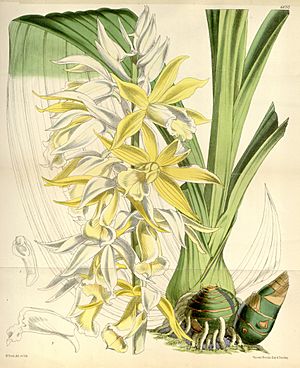Yellow swamp orchid facts for kids
Quick facts for kids Yellow swamp orchid |
|
|---|---|
 |
|
| Conservation status | |
| Scientific classification |
|
| Kingdom: | Plantae |
| Clade: | Tracheophytes |
| Clade: | Angiosperms |
| Clade: | Monocots |
| Order: | Asparagales |
| Family: | Orchidaceae |
| Subfamily: | Epidendroideae |
| Genus: | Phaius |
| Species: | |
| Varietas: |
P. t. var. bernaysii
|
| Trinomial name | |
| Phaius tankervilleae var. bernaysii (F.Muell. ex Rchb.f.) J.V.Stone & P.J.Cribb
|
|
| Synonyms | |
|
|
The yellow swamp orchid (Phaius tankervilleae var. bernaysii) is a special type of orchid. It grows only in a small part of Queensland, Australia. This plant is an evergreen herb that grows in the ground.
It has large, crowded pseudobulbs (which are like swollen stems that store water). Its leaves are big and pleated. The flowers are white on the outside and bright yellow inside. This orchid looks almost exactly like another type, P. tankervilleae var. bernaysii, except for its flower color.
Contents
What Does the Yellow Swamp Orchid Look Like?
The yellow swamp orchid is an evergreen plant that grows from the ground. It has thick, crowded pseudobulbs. These pseudobulbs are about 50 to 70 mm (2.0 to 2.8 in) long and wide.
The plant usually has four to eight dark green leaves. These leaves are shaped like a spear and are pleated. They can grow up to 50 to 125 cm (20 to 49 in) long and 80 to 100 mm (3.1 to 3.9 in) wide. The leaves are narrower at their base.
Between four and sixteen thick flowers grow on a long stem. This stem can be 50 to 200 cm (20 to 79 in) tall. The flowers themselves are quite large, about 60 to 100 mm (2.4 to 3.9 in) long and 65 to 110 mm (2.6 to 4.3 in) wide.
These flowers are the biggest of all Australian orchids. Their outer parts are white, and their inner parts are a bright sulfur yellow. The sepals (outer flower parts) are 45 to 55 mm (1.8 to 2.2 in) long and 12 to 20 mm (0.47 to 0.79 in) wide. The top sepal points upwards, and the side sepals spread out wide.
The petals (inner flower parts) are similar in size to the sepals. The labellum (a special lip-like petal) is 50 to 60 mm (2.0 to 2.4 in) long and 40 to 45 mm (1.6 to 1.8 in) wide. It has three parts and can be yellow to bright purple.
The middle part of the labellum has wavy edges. The side parts might form a tube around the column (the central part of the flower). Sometimes, they spread out widely. This orchid blooms in Australia between September and November.
How the Yellow Swamp Orchid Got Its Name
The yellow swamp orchid was first officially described in 1873. A scientist named Heinrich Gustav Reichenbach gave it the name Phaius bernaysii. He gave credit to "Dr Rowland" for finding it. The description was published in a magazine called The Gardeners' Chronicle. Reichenbach thought Dr Rowland named it to honor Lewis Adolphus Bernays.
Later, Lewis Bernays wrote a letter to The Gardeners' Chronicle. He explained that he had collected the plants himself. He sent them to Ferdinand von Mueller and his friend "Dr Rowland of Malvern." Dr Rowland was supposed to take them to a plant company in London.
It seems that the original description was actually written by von Mueller. Reichenbach might not have known this. Today, the World Checklist of Selected Plant Families lists Ferdinand von Mueller as the author.
In 2017, two scientists, Judi Stone and Phillip James Cribb, studied the Phaius group of orchids. They wrote a detailed book called Lady Tankerville's Legacy. In their book, they changed Phaius bernaysii to be a variety of Phaius tankervilleae.
Where the Yellow Swamp Orchid Lives
The yellow swamp orchid grows in swampy forests near the coast. You can find it on Stradbroke Island in Queensland. In the past, it was also seen on Peel Island, Bribie Island, and at Noosa Heads.
Protecting the Yellow Swamp Orchid
The yellow swamp orchid, known as Phaius bernaysii, is an "endangered" species. This means it is at high risk of disappearing forever. Both the Australian and Queensland governments protect it under special laws. These laws are the Environment Protection and Biodiversity Conservation Act 1999 and the Nature Conservation Act 1992.
There are several reasons why this orchid is in danger. People sometimes illegally collect the plants and their flowers. Also, fires in its habitat are not happening in the right way. Changes in the water levels of the swamps where it lives, caused by human activities, also threaten it.


